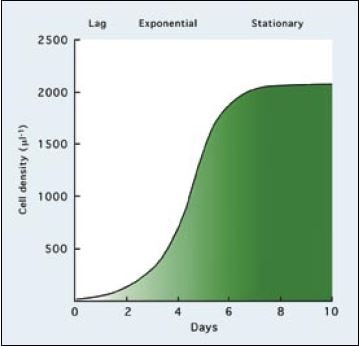3.3.1 Growth phases of cultures
Harvesting takes place in semi-continuous culture during the exponential phase of growth. Batch harvests are made generally at the peak of exponential growth as the cultures enter the stationary phase. An illustration of the meaning of these terms is given in Figure 19. In this case the species cultured is the large, green flagellate, Tetraselmis.

Figure 19: Phases in the growth of algal cultures illustrated by a typical growth curve for the large, green flagellate, Tetraselmis suecica.
At inoculation from the starter culture, the starting cell density in the culture is 25 to 50 cells per ml (cells per microlitre). After inoculation these cells grow and divide increasingly rapidly as they acclimatize to the culture conditions.
This acclimatization period, which lasts for 2 to 3 days, is called the lag phase. Once adapted to the conditions, the rate of cell division accelerates and increase in the number of cells in the culture is logarithmic. This period lasts for 4 to 6 days and is called the exponential growth phase. Cell division rate then slows as light penetration through the culture and/or nutrients become limiting. The culture then enters the stationary phase, which can last for many days in the case of flagellates or only for a short time for diatoms. Cultures of flagellates remain in this phase by the recycling of nutrients from dead and decaying cells, but in the case of diatoms, which may produce self-inhibiting metabolites, which attract bacterial growth, the culture collapses.
In the example shown in Figure 19, batch cultures of Tetraselmis would be harvested at a density of about 2 000 cells per ?l and semi-continuous cultures at about 1 500 cells per ?l. These densities can be increased, within limits, by increasing the light intensity falling on the cultures, by maintaining the pH at between 7.5 to 8.2 with controlled CO2 input and by the addition of extra nutrients as the culture density increases.